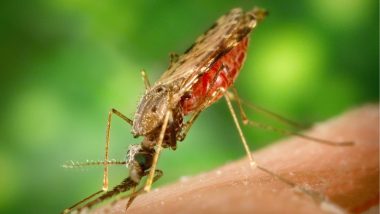New Delhi, Dec 2: The WHO's World Malaria Report (WMR) 2020, which provides estimated cases for malaria across the world based on mathematical projections, indicates that India has made considerable progress in reducing its malaria burden, the Union health ministry said on Wednesday.
India is the only high endemic country which has reported a decline of 17.6 per cent in 2019 as compared to 2018 as far as malaria cases are concerned, it said.
"The Annual Parasitic Incidence (API) reduced by 27.6 per cent in 2018 as compared to 2017, and by 18.4 per cent in 2019 as compared to 2018. India has sustained API less than one since year 2012," the ministry said.
India has also contributed to the largest drop in such cases region-wide, from approximately 20 million to about 6 million. Delhi Records 24% Rise in Dengue, Malaria And Chikungunya Cases in 7 Days.
The percentage drop in the malaria cases was 71.8 per cent and deaths was 73.9 per cent between 2000 to 2019, the ministry said.
India achieved a reduction of 83.34 per cent in malaria morbidity and 92 per cent in malaria mortality between the year 2000 (20,31,790 cases, 932 deaths) and 2019 (3,38,494 cases, 77 deaths), thereby achieving Goal 6 of the Millennium Development Goals (50-75 per cent decrease in case incidence between 2000 and 2019).
"Decrease in incidence of malaria cases is also exhibited in the year-on-year tally. The cases and fatalities have declined significantly by 21.27 per cent and 20 per cent, respectively in the year 2019 (3,38,494 cases, 77 deaths) as compared to 2018 (4,29,928 cases, 96 deaths).
"The total number of malaria cases reported in 2020 till October(1,57,284) has further decreased by 45.02 per cent as compared to the corresponding period of 2019 (2,86,091)," the ministry said.
Malaria elimination efforts were initiated in the country in 2015 and intensified after the launch of the National Framework for Malaria Elimination (NFME) in 2016 by the Ministry of Health and Family Welfare.
The National Strategic Plan for Malaria Elimination (2017-22) was launched by the health ministry in July, 2017 which laid down strategies for the next five years.
The first two years saw a 27.7 per cent decline in cases and 49.5 per cent reduction in fatalities; 11,69,261 cases and 385 deaths in 2015, and 8,44,558 cases and 194 deaths in 2017.
The states of Odisha, Chhattisgarh, Jharkhand, Meghalaya and Madhya Pradesh disproportionately accounted for nearly 45.47 per cent (1,53,909 cases out of India's 3,38,494 cases) of malaria cases and 70.54 per cent (1,10,708 cases out of India's 1,56,940 cases) of falciparum malaria cases in 2019.
The health ministry said 63.64 per cent (49 out of 77) of malaria deaths was also reported from these states.
"Due to the efforts made by the Government of India in provision of microscopes, rapid diagnostics Long Lasting Insecticidal Nets (LLINs) – about 5 crore of them have been distributed in seven northeast states, Chhattisgarh, Jharkhand, Madhya Pradesh and Odisha up to 2018-19 and another 2.25 crore LLINs are being supplied/distributed during the current financial year to high burden areas leading to reduction in endemicity in these otherwise very high endemic states.
"An additional procurement of 2.52 crore LLINs has also been initiated," it said.
Use of LLINs has been accepted by the community at large and has been one of the main contributors to the drastic malaria decline in the country.
The World Health Organisation (WHO) has initiated the High Burden to High Impact (HBHI) initiative in 11 high malaria burden countries, including India.
The implementation of the 'High Burden to High Impact (HBHI)' initiative was started in four states, namely, West Bengal, Jharkhand, Chhattisgarh and Madhya Pradesh in July, 2019.
"A key strategy to reignite progress is the HBHI response, catalysed in 2018 by WHO and the RBM Partnership to End Malaria continued to make impressive gains in India, with 18 per cent reductions in cases and 20 per cent reduction in deaths over the last two years," the ministry said.
Malaria has been made notifiable in 31 states and UTs and the decline has been observed in the hitherto high endemic states.
Percentage of decline in the year 2019 as compared to 2018 is as follows: Odisha – 40.35 per cent, Meghalaya- 59.10 per cent, Jharkhand – 34.96 per cent, Madhya Pradesh –36.50 per cent and Chhattisgarh –23.20 per cent.
The figures and trends between the last two decades clearly show the drastic decline in malaria. The malaria elimination target of 2030 looks achievable building on the Union government's strategic interventions in this regard, the ministry added.













 Quickly
Quickly





















